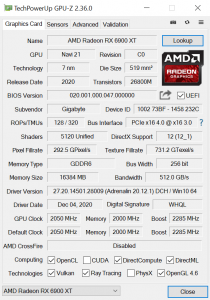
Today we are back with our first review of a custom RX 6900 XT graphics card. AMD first introduced the 6900 XT in December last year, but it has taken until now for a custom card to pass through our labs. The model in question is Gigabyte's RX 6900 XT Gaming OC, outfitted with a triple-fan, triple-slot cooler as well as dual-BIOS functionality. How does this compare to AMD's reference design?
We've already reviewed one Gigabyte Gaming OC card this generation, but that was back in November with a look at the RTX 3070 model. Despite that being an Nvidia GPU, and this is AMD, Gigabyte has kept the overall design philosophy very similar for the RX 6900 XT Gaming OC. Emphasis is placed on the large cooler, the choice of BIOS modes, and a minimalistic approach to RGB lighting. The GPU core has also received a slight boost compared to reference spec, with a 35MHz bump to the rated boost clock.
In this review we find out exactly how the two BIOS modes differ while testing power, noise, thermals and more. We also benchmark seven demanding titles to see just how much faster the Gaming OC is compared to AMD's reference card.
| RX 6900 XT | RX 6800 XT | RX 6800 | RX 5700 XT | RX 5700 | |
| Architecture | RDNA 2 | RDNA 2 | RDNA 2 | RDNA | RDNA |
| Manufacturing Process | 7nm | 7nm | 7nm | 7nm | 7nm |
| Transistor Count | 26.8 billion | 26.8 billion | 26.8 billion | 10.3 billion | 10.3 billion |
| Die Size | 519 mm² | 519 mm² | 519 mm² | 251 mm² | 251mm² |
| Ray Accelerators | 80 | 72 | 60 | n/a | n/a |
| Compute Units | 80 | 72 | 60 | 40 | 36 |
| Stream Processors | 5120 | 4608 | 3840 | 2560 | 2304 |
| Game GPU Clock | Up to 2015MHz | Up to 2015MHz | Up to 1815MHz | Up to 1755MHz | Up to 1625MHz |
| Boost GPU Clock | Up to 2250MHz | Up to 2250MHz | Up to 2105MHz | Up to 1905MHz | Up to 1725MHz |
| Peak SP Performance | Up to 23.04 TFLOPS | Up to 20.74 TFLOPS | Up to 16.17 TFLOPS | Up to 9.75 TFLOPS | Up to 7.95 TFLOPS |
| Peak Half Precision Performance | Up to 46.08 TFLOPS | Up to 41.47 TFLOPS | Up to 32.33 TFLOPS | Up to 19.5 TFLOPS | Up to 15.9 TFLOPS |
| Peak Texture Fill-Rate | Up to 720 GT/s | Up to 648.0 GT/s | Up to 505.2 GT/s | Up to 304.8 GT/s | Up to 248.4 GT/s |
| ROPs | 128 | 128 | 96 | 64 | 64 |
| Peak Pixel Fill-Rate | Up to 288.0 GP/s | Up to 288.0 GP/s | Up to 202.1 GP/s | Up to 121.9 GP/s | Up to 110.4 GP/s |
| AMD Infinity Cache | 128MB | 128MB | 128MB | n/a | n/a |
| Memory | 16GB GDDR6 | 16GB GDDR6 | 16GB GDDR6 | 8GB GDDR6 | 8GB GDDR6 |
| Memory Bandwidth | 512 GB/s | 512 GB/s | 512 GB/s | 448 GB/s | 448 GB/s |
| Memory Interface | 256-bit | 256-bit | 256-bit | 256-bit | 256-bit |
| Board Power | 300W | 300W | 250W | 225W | 185W |
The make-up of the RX 6900 XT GPU has many similarities to the RX 6800 XT. Still fabricated on TSMC’s 7nm process node, it uses the same Navi 21 GPU, measuring 519 mm². The key difference is that the RX 6900 XT silicon is fully populated, with 80 Compute Units (CUs) compared to 72 for the 6800 XT. This means the flagship chip has an extra 512 Stream Processors, giving a grand total of 5120 shaders.
Rated clock speed is also identical between these two RDNA 2 GPUs. Reference RX 6900 XT has a rated game clock of 2015MHz and a rated boost clock of up to 2250MHz, but Gigabyte has pushed the rated boost clock up to 2285MHz, a 35MHz increase.
AMD has also increased the memory capacity, with 16GB of GDDR6 memory found on every RX 6000 SKU (so far). The memory is clocked at 16Gbps, and operates over a 256-bit memory interface for total bandwidth of 512 GB/s. However, AMD has also implemented a 128MB Infinity Cache on the Navi 21 GPU, to significantly increase effective memory bandwidth without excess power draw.
Speaking of power, the reference RX 6900 XT has a rated total board power (TBP) of 300W. Gigabyte has increased this with the Gaming OC model, to 315W based on our testing, but we look at power draw in more detail later on in the review.
 KitGuru KitGuru.net – Tech News | Hardware News | Hardware Reviews | IOS | Mobile | Gaming | Graphics Cards
KitGuru KitGuru.net – Tech News | Hardware News | Hardware Reviews | IOS | Mobile | Gaming | Graphics Cards




